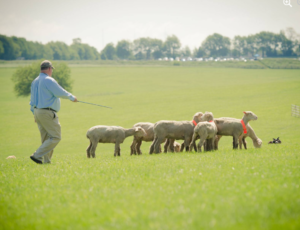From Mike Neary
Mike Neary is a doctor of Animal Sciences, professor and extension sheep specialist at Purdue University, past President of the American Border Collie Association, a respected and successful handler and sought-after judge. Mike has been trialing for many years and we are very fortunate to have his insight into why it’s important to understand and appreciate the sheep. We are extremely appreciative of the fact that he took time from his busy schedule to write this post, and we highly recommend his recently published book “Sheep for Sheepdogs.” It is an invaluable resource for the trialing community.
Here’s what Mike has to say:

There are 3 things crucial to working a dog; the handler, the sheep, and the dog. Of the 3, the dog and sheep know instinctively what to do. With a talented and well-bred dog, usually, the weak link in a partnership is the handler. Yet, the human has a big brain. Most handlers spend much time and effort learning how to train and work dogs. Clinics, lessons, online courses, books, videos are all used extensively to learn about the dogs. I’m here to tell you- don’t forget to learn about sheep.
One thing that will help people immensely with their training and handling is to make sheep knowledge a priority, a real priority, not just a fake one. Don’t forget about the sheep, because your dog won’t. It is the motivator for them, the thing that every
fiber in their body tells them to do. Don’t forget about the sheep if you want trust and respect from your dog.
If you struggle reading sheep your dog will know. If you struggle reading sheep your dog will doubt you. If your dog doubts you, and doesn’t trust you, that magical partnership can’t develop. It just can’t. They may be biddable and obey commands, but the highest level possible of the partnership won’t be attained.
The sport of dog trialing has changed much since I started with the dogs many years ago. Then, it was mostly farmers or ranchers, or ones that were retired, running dogs. Most had a lifetime of working with livestock, and thus, had an innate understanding of behavior and movement of them. Times have changed, many people now got into the sport because of their dogs and not because they needed a dog to work stock. The stock came after the dog. I welcome this, it’s good for the livestock industry if more
people learn about stock and come to appreciate all that goes into raising food and fiber.
In fact, I have many friends that got into dog trialing without livestock experience. Many of them have become sheep owners and have learned much about the industry. This is a good thing, welcome newcomers to the industry. How do you learn about sheep? Well, no one is born knowing, it is an acquired skill, like most things in life. First is the required mindset; sheep are not dog toys that are there to make your dog “whole”.
They are gentle, noble creatures that have contributed immeasurably to the development of mankind over many centuries. They deserve to be treated respectfully.
One has to have the correct attitude about sheep if knowledge is to be truly acquired; a respect, a natural curiosity, and a real motivation to learn about them. The other great thing about sheep is, like the dogs, the learning never ends. There’s always something new. The best way to learn about sheep behavior is to spend time around them without a dog. Moving them, working with them, observing their reactions. The best way to understand what makes sheep tick is to know their insecurities and fears. The biggest driver of sheep behavior is that they are prey animals and don’t really have a good defense mechanism. The biggest defense is to flee danger and to group
together with other sheep. So, try to move sheep without a dog where they aren’t inclined to go.
Learn where the edge of the flight zone is, learn where the balance point is, learn how to apply and release pressure to move them. Learn how to release pressure by using small steps, backing up, repositioning, how your body posture affects them, turning your back to them, looking away, and so on. Learn how to apply pressure with the same concepts. Learn how your positioning affects the sheep. Be slow, be deliberate, and be observant. Above all, be patient. If you want the full Monty of learning about sheep behavior, lamb a bunch of ewes out. All the behaviors are present during that time period.
Shameless plug here- I have a book out that was published in 2019 entitled “Sheep for Sheepdogs”. It is modestly priced and I wrote it primarily to help the newcomers to the sport without extensive sheep experience. It is available at Outrun Press or on Amazon.